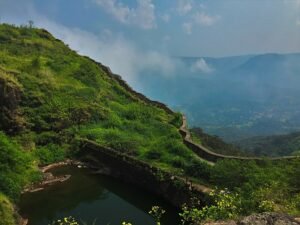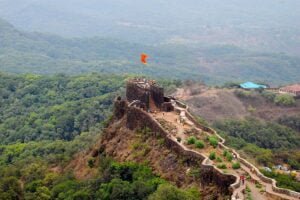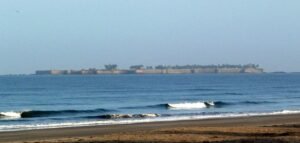No products in the cart.
MAHARASHTRA: Maratha Military Landscapes of India
MAHARASHTRA
Symbols of the Power and Glory of Maratha Might
India has sought to get UNESCO to recognize its ‘Maratha Military Landscapes’ as a World Heritage Site for the year 2024-2025.
The Maratha military ideology dates back to the 17th Century during the reign of the Maratha ruler Chhatrapati Shivaji Maharaj by 1670 CE and carried on through subsequent rules until Peshwa rule till 1818 CE.
Situated across different geographies the forts are reflective of the strategic military prowess and visionary trajectory of Maratha rule in the country.
The ‘Maratha Military Landscapes’ has been nominated in UNESCO’s category of cultural criteria. Included in the Tentative List of World Heritage sites in 2021 it is the sixth cultural property nominated for inclusion in the World Heritage List from Maharashtra.
The collective of these heritage structures for the ‘Maratha Military Landscapes’ includes the Salher Fort, Shivneri Fort, Lohagad, Khanderi Fort, Raigad, Rajgad, Pratapgad, Suvarnadurg, Panhala Fort, Vijay Durg and Sindhudurg in Maharashtra state; one of the 12 included in this list for nomination is Gingee Fort, located in the state of Tamil Nadu.
The ‘Maratha Military Landscapes of India’ is a showcase of the development between the 17th and 19th centuries, of an extraordinary fortification and military system conjured up by the Maratha rulers to strengthen their hold on the territories under them to repel their foes — and for further conquests. What stands out about this astonishing network of fortifications is the unique integration of the landscape, terrain, and physiographic characteristics that are distinctive to the Sahyadri mountain ranges, the Konkan Coast, the Deccan Plateau, and the Eastern Ghats in the Indian Peninsula.
Though the state of Maharashtra is home to over 390 forts, only 12 of these come under the umbrella of the ‘Maratha Military Landscapes of India’. Of these eight are protected by the Archaeological Survey of India. The remaining— Salher Fort, Rajgad, Khanderi Fort, and Pratapgad are protected by the Directorate of Archaeology and Museums, Government of Maharashtra.
Of the 12, Salher Fort, Shivneri Fort, Lohgad, Raigad, Rajgad, and Gingee Fort are hill forts; Pratapgad is a hill-forest fort; Panhala is a hill-plateau fort; Vijaydurg is a coastal fort and Khanderi Fort, Suvarnadurg and Sindhudurg are island forts.
One of the most appealing tourist attractions in Maharashtra is its ancient forts which wing us back to bygone eras and the many exploits of the rulers of these kingdoms which they represent.
Let’s have a look at a few of these which are being nominated for their unique history, heritage, and cultural contributions to the annals of India’s many narratives.
Lohagad Fort
Built by Raja Bhoj in the 12th century, over time it came to be held by the Sarvananas, Chalukyas, Rashtrakutas, Yadavas, Bahamanis, Nizams, Mughals, and Marathas. It was wrested by Chhatrapati Shivaji Maharaj from the Mughals in 1648.
The fort is located close to the hill station of Lonavala and about 50 km away from Pune.
The four arched defence gateways to the stronghold go by the names of Ganesh Gate, Narayan Gate, Hanuman Gate, and Maha Gate. The massive doors are studded with spikes. The Maha Gate opens onto a Trimbakeshvar Mahadev Temple. Around the front entrance is also a tomb surrounded by remnants of smaller structures that appear to have served as admin offices. An unmissable find yielded by the site is the treasury giving more heft to the fact that the fort was used to house Nana Fadnavis’ treasure, once it was wrested from the Mughals.
Another cave unearthed here is known by the locals as Lakshmi Kothi which may have Buddhist links. The fort also houses the tomb of Shaikh Umar Avalia, an Arab saint. The annual fair at the tomb is well attended by the Muslim community.
Dotted with several water tanks, the most alluring being the 16-cornered tank. An inscription ascribes its maker as Balaji Janardan Bhanu/Nana Fadnavis. An extension of the fort known as ‘Vinchu Kada’ or scorpion’s tail offers stunning panoramas of the surrounds!
Shrouded by the monsoon mists it takes on a mystical, mysterious air. Summertime finds trekking enthusiasts on an extensive exploration of its grand interiors it’s a stiff 30-minute hike up to the fortress but the views of its surrounds and interior features are worth it.
Pratapgad Fort
 Pratapgad Fort lies 25km away from the popular hill town of Mahabaleshwar. Trekkers enjoy the prospect of a lively half-day tour of the site. Shivaji directed his prime minister Moropant Trimbak Pingle to set up the fort to safeguard the embankments of the Koyna and Nira rivers. Completed in 1656, the first battle it witnessed was between Shivaji and Afzal Khan, the general of Adil Shah of Bijapur, in 1659. It was a significant milestone in establishing the military might of the fledgling Maratha kingdom which went on to become a power to be reckoned with in the Deccan. Local lore has it that the remains of Afzal Khan were interred under the tower in the lower fort.
Pratapgad Fort lies 25km away from the popular hill town of Mahabaleshwar. Trekkers enjoy the prospect of a lively half-day tour of the site. Shivaji directed his prime minister Moropant Trimbak Pingle to set up the fort to safeguard the embankments of the Koyna and Nira rivers. Completed in 1656, the first battle it witnessed was between Shivaji and Afzal Khan, the general of Adil Shah of Bijapur, in 1659. It was a significant milestone in establishing the military might of the fledgling Maratha kingdom which went on to become a power to be reckoned with in the Deccan. Local lore has it that the remains of Afzal Khan were interred under the tower in the lower fort.
Up in the higher reaches of the fort in a small garden, a statue of Shivaji astride a horse dominates the central space.
Panhala Fort
Also known as the ‘Fort of Snakes’ because of its sinuous structure the fort, 20km from the city of Kolhapur, was commissioned by Bhoja II, the Shilahara ruler. As yielded by an inscription on a copper plate Raja Bhoja is said to have held court at Panhala from 1191–1192 CE. Under the Adil Shahi dynasty of Bijapur in 1489, Panhala underwent sizeable development. It was wrested by Shivaji from Bijapur in 1659. The following year Adil Shah reclaimed the fort after massive losses encountered by Shivaji. It was only in 1673 that Shivaji got to grab it back.
Located at a height of 845 m, and a perimeter of 14 km, and pierced by 110 lookout posts it was the largest fort in the Deccan. Additional heft came from the fact that Panhala Fort straddled a strategic point in the trade route in the Sahyadri range from Bijapur in the interior of Maharashtra to the coastal region. You can still see the iconic peacock motif of the Bahmani Sultanate on several structures in the fortress.
Structures of note are the Andhar Bavadi (Hidden Well) to counter the water tanks being poisoned by the enemy; it also featured several secret tunnels leading out of the fort. The Kalavanticha Mahal was the Terrace Room of the Courtesans now almost gone with barely any traces of its former grandeur. The Amberkhana was a set of three granaries, which proved to be very handy during the 5-month siege by Siddhi Johar Shivaji had to endure. The Sajja Kothi was a viewing pavilion built by Ibrahim Adil Shah in 1500 CE. Of the three temples at the site, raised to Sambhaji II, Someshwar, and Ambabai, Shivaji would pray to the last one before any campaign.
The one structure that has resisted the onslaught of time, the Tararani Palace, now serves as the site for a school, some government offices and a hostel for boys.
The British were to claim in Panhala in 1827. The fortification was studded with over 150 wells, but most of them were closed up due to major roadworks that were carried out once civilians were permitted to settle in it by the British.
Sindhudurg Fort
The stunning location of this island fort in the Malvan town of Maharashtra has mesmerized streams of visitors over many decades. This forbidding structure was indeed an impenetrable bastion surrounded by water and unforgiving cliffs. Developed between 1664 and 1667 on Kurte Island, Sindhudurg played a pivotal role as the headquarters of the Maratha Navy and in daunting enemies such as the Siddhis, Portuguese, and British. The Maratha navy under Shivaji served as valiant watchdogs in these waters to repel their advances, with adroit strategies to protect its coastlands.
The fort was considered the most invaluable asset for Shivaji. The only temple dedicated to Shivaji is to be found in this fort; known as the Shree Shiv Chhatrapati Temple it features a statue of the ruler, as well as his original sword. It was commissioned by his son Rajaram in 1695. The foot and handprints of Shivaji can be seen set in a dry lime slab embedded in a turret above the entrance.
In 1765 Major Gordon and Captain Watson captured the fort and renamed it Fort Augustus. By an Anglo-Maratha truce forged in 1766 the fort was returned to Marathas. In 1792 the British again regained the fort by helping Karveerkars against Desai of Nipani.
Sindhudurg also known as the ‘jal rajdhani’ or the ‘water capital’, is today a serene and scenic tourist spot, its nearby waters are dotted by jet-skis, speed boats, and wind surfing enthusiasts.
Access to the fort is by ferry; but not during the monsoons. It is maintained by the Archaeological Survey of India and the Government of Maharashtra.
















